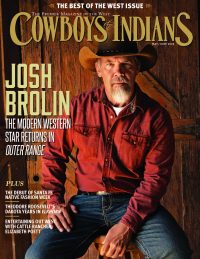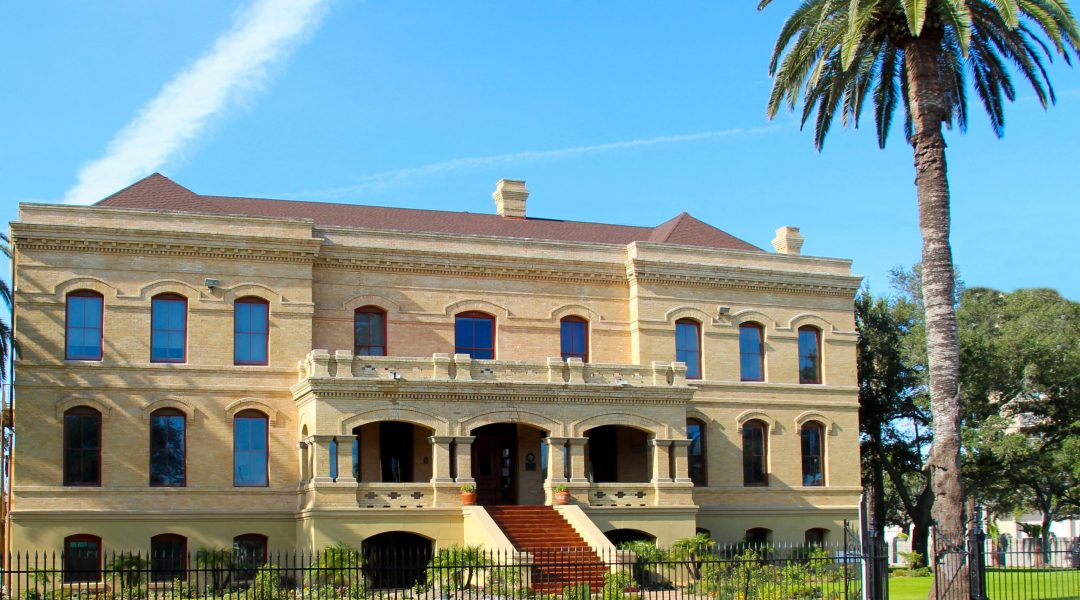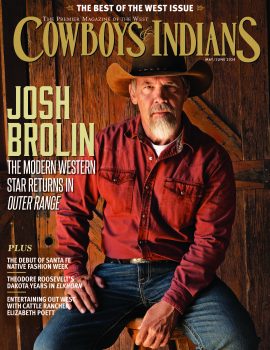
Here’s what founder J.P. Bryan, museum director Jamie Christy, and curator Andrew Gustafson say you really need to see.
There’s much to enjoy in Galveston, Texas: the beach Glen Campbell sang about, the seawall, Moody Gardens, Dickens on The Strand at Christmas, the Ocean Star Offshore Drilling Rig and Museum, burgers and beer at The Spot, seafood at Shrimp ’N Stuff, pecan pie at Gaido’s. And now, there’s the Bryan Museum. Opened in June 2015, it houses the nation’s most comprehensive collection of historic Western objects in a building that’s nearly as historic and impressive as the treasures inside.
As far as founder J.P. Bryan is concerned, the story of the West is, next to the Good Book, the greatest story ever told. And he’s spent the better part of his 75 years collecting items that tell it. “What gave me the confidence to go ahead with the museum,” he says, “was the fact that we were telling a story that nobody was telling before. That’s our distinction: Nobody else tells the entire story.”
He’s modest about his role, but he will allow that he knows a thing or two about the subject. “I did not research everything in the collection, but I was personally involved in every acquisition decision,” Bryan says. “If you define a collector as someone who loves what he’s doing, and understands and is part of the decision-making, I meet the definition. I have a real personal affection for the collection. The pieces have their own stories to tell and I know what they are.”
Bryan originally was going to name his new museum Visions of the West. “I didn’t want it to seem like it was about me. I didn’t really feel comfortable calling it the Bryan Museum, but eventually I thought, Well, there are a lot of Bryans that played a role in the settlement of Texas. It’s a way to honor the entire family. I hope the museum inspires my children and grandchildren to make their contributions to art and history and play an important role in preserving or promoting it.”
If they do, they’ll be guardians of, among other things, the largest repository of paintings by “The Dean of Texas Painters,” Frank Reaugh. And, if Bryan hasn’t already found and bought the Holy Grail for any collector of Texas-related material, they, too, will be on the hunt for the extremely rare Texas Declaration of Independence from Mexico. In the meantime, here’s the don’t-miss-list from founder J.P. Bryan, museum director Jamie Christy, and curator Andrew Gustafson.
The Bryan Museum Highlights
Conquistador Helmet
Worn by European soldiers for protection in the New World, this style of helmet, introduced in the 16th and 17th centuries, is similar to the Italian-designed cabasset. Feather plumage can be attached to the crest of the helmet.
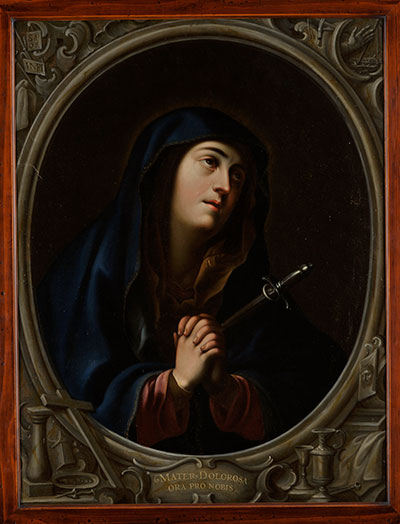
Mater Dolorosa (Our Lady of Sorrows)
This oil painting features the Virgin Mary following the crucifixion of Christ. The incredible tears on her cheek indicate the level of her sorrow and a metaphorical knife jabs at her breast. Painted on copper and dating to the 17th century, this religious artwork or retablo is perhaps the finest of its kind in the collection.
Stephen F. Austin’s Calling Card
Stephen F. Austin used this calling card, likely printed in New Orleans and shipped to Texas, during his time as empresario (the contracted business leader of a government-approved colony project in Texas) or possibly during the Texas Revolution. It indicates that he was “of Texas.” He may have used this card while traveling to the United States in 1835 and 1836 to raise money for the Texas Revolution, or possibly during the few months he was alive after the Republic of Texas had been formed. This card is from the Bryan family collection.
La Relación (the Memoir) of Cabeza de Vaca
Survivors of an ill-fated expedition led by adventurer Panfilo de Narváez — which set sail from Spain in 1527 with ambitious but naive plans to colonize the region between Spanish Florida and Tampico, Mexico — washed ashore near present-day Galveston in late 1528. Of 300 men who set out to explore the inland Gulf Coast, only four survived. One of them, Álvar Núñez Cabeza de Vaca, became the first historian and ethnologist of Texas, and an advocate for Indian rights in New Spain. He published a treatise on the diverse peoples and cultures he encountered including his experiences during the six years he lived and traveled among them. This printed book with vellum cover was published in 1551, the second edition of this remarkable memoir.
Buffalo Hide Pueblo/Comanche Shield
This shield was made between 1780 and 1800 from two-ply buffalo hide. It is an example of the inter-ethnic contact between peoples in the late Spanish Colonial period. The Rio Grande Pueblos created the shield using a Spanish stitching technique. It was traded with a Plains tribe, most likely the Comanches, and used as a war shield. Around 1900, the shield was returned to the Cochiti Pueblos for ceremonial purposes, indicated by the faint mineral and vegetable paints still on the front.
San Jacinto Diorama

This one-of-a-kind landscape diorama, opened in November 2015, depicts the Battle of San Jacinto, fought on April 21, 1836. Featuring nearly 2,000 toy soldiers created by KINGS X on an authentic landscape, this diorama shows the moment the Texas forces, under the command of Gen. Sam Houston, began their clash with the Mexican army, led by Gen. Antonio López de Santa Anna. Measuring 7 feet by 10 feet, the diorama is exhibited in a nearly all-glass case, complete with iPad interactives containing more information about the battle and its participants.
Gold Saddle Wedding Ring Designed by Charles Russell
Famed American artist Charles Marion Russell designed this distinctive wedding ring. His wife, Nancy Cooper Russell, wore the ring during their marriage. It was created from a 24kt gold nugget and shaped as a Western saddle. This ring is likely one of the first three-dimensional sculpture works accomplished by Russell. Two years later, in 1898, spurred on by Nancy’s support, Russell cast his first bronze at the Roman Bronze Works in New York. The ring is approximately a size 6.
Woman’s Side-Saddle Designed by Charles Goodnight
This saddle was created using a design developed by legendary cattle rancher Charles Goodnight. Goodnight designed the working side-saddle for his wife, Molly. It features a slightly inclined seat, a small stirrup, and a vestigial horn or “grab handle.” Goodnight intended the saddle to be a working saddle for day-to-day ranch life.
Receipt Signed by William B. Travis at the Alamo
William Barret Travis (1809–1836) signed this document while commander at the Alamo. It is a receipt for supplies such as alcohol, tobacco, lead, and gunpowder needed for the garrison and received from Luciano Navarro, a prominent Tejano merchant in San Antonio. It is dated February 20, 1836, just three days before the Battle of the Alamo commenced.
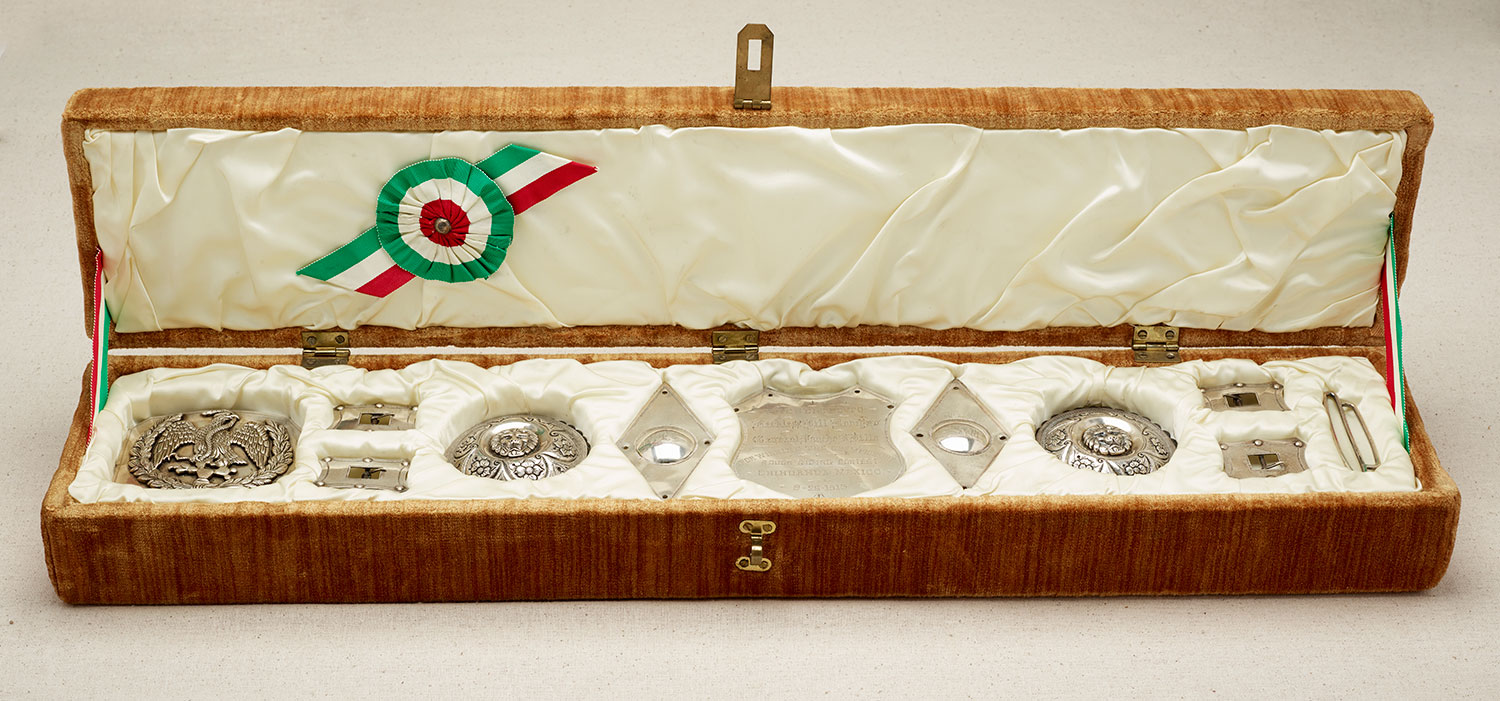
Silver Buckle Set Presented to “Reckless” Bill Rodigo From Gen. Pancho Villa
Solid silver belt buckle and saddle accouterments, presented to “Reckless” Bill Rodrigo as winner of a rough riding competition hosted in Mexico in 1913. Gen. Francisco “Pancho” Villa served as judge for the competition and his name is etched into the belt buckle.
Manual Para Administrar los Santos Sacramentos
Priests or monks used this manual for administering the Catholic sacraments: Baptism, Eucharist (Communion), Confirmation, Penance, Extreme Unction (Anointing of the Sick/Last Rights), Holy Orders, and Matrimony. The title page on display is from a first edition printing from 1760, published in Mexico City. The book has a vellum or calfskin cover with ties. The manual is in both Spanish and Pakawá, the language of Texas Indians (Coahuiltecans) living along the San Antonio and Rio Grande rivers, and is the only surviving account of that language. Pakawá was the most common language in central Texas, spoken by some 50 nomadic tribes, although it is believed to be extinct today. Fray Bartolomé García was a Franciscan missionary in Texas for 12 years and was at the Nuestro Padre San Francisco de los Tejas Mission near San Antonio when he wrote this work.
José Cisneros Collection
The José Cisneros Collection chronicles much of the Spanish and American West with precise pen-and-ink illustrations. Cisneros was born in revolution-era Mexico and moved to El Paso, Texas. He researched his topics thoroughly and presented authentic images of life in the West and Southwest. The collection contains a vast research library of several thousand books and periodicals, hundreds of personal and business letters, unframed finished artwork, as well as rough sketches and a collection of signed books illustrated by the artist. Another section of the collection contains finished framed pen-and-ink artworks, on view in the museum. Overall, the collection chronicles Cisneros’ growth as an artist and scholar.
Read more about the Bryan Museum.



